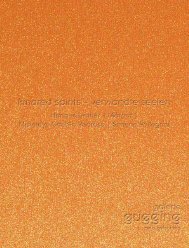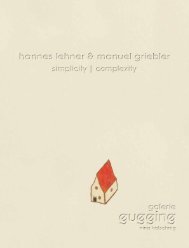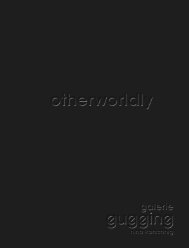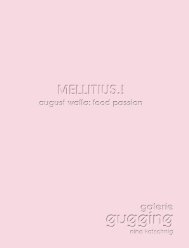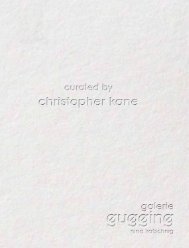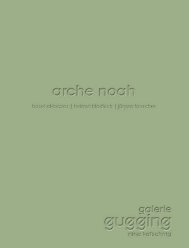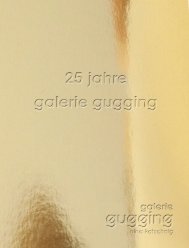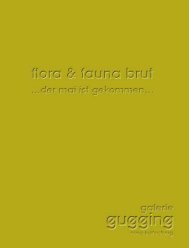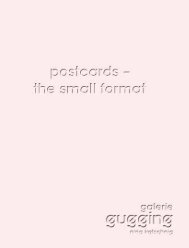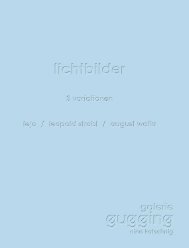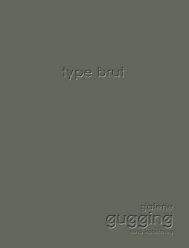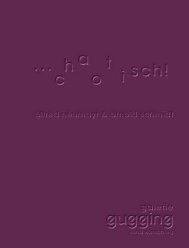Katalog_überdrüber
überdrüber... leopold strobl & arnulf rainer
überdrüber... leopold strobl & arnulf rainer
Erfolgreiche ePaper selbst erstellen
Machen Sie aus Ihren PDF Publikationen ein blätterbares Flipbook mit unserer einzigartigen Google optimierten e-Paper Software.
1
<strong>überdrüber</strong>…<br />
leopold strobl & arnulf rainer
<strong>Katalog</strong> zur Ausstellung „<strong>überdrüber</strong>…“, 19. November 2020 – 07. März 2021<br />
Catalogue of the exhibition “over above…”, November 19, 2020 – March 7, 2021<br />
galerie gugging – nina katschnig, Am Campus 2, 3400 Maria Gugging<br />
t: +43 676 841 181 200, office@galeriegugging.com, www.galeriegugging.com
<strong>überdrüber</strong>…<br />
leopold strobl & arnulf rainer
Nina Katschnig<br />
Vorwort<br />
Leopold Strobl kennt Arnulf Rainer persönlich und beschreibt die Begegnung, die sie<br />
hatten, als „durchaus angenehm“. Er erzählt mir, dass Arnulf Rainer einmal bei uns im<br />
atelier gugging zu Besuch war, als er gerade eben dort gearbeitet hat. Arnulf Rainer war<br />
und ist seit jeher an Kunst außerhalb des Mainstreams interessiert und hat viele Ateliers<br />
besucht.<br />
Die Werke der jetzigen Künstler aus Gugging waren in den 1960er und 1970er Jahren<br />
durch Leo Navratils Publikationen „Schizophrenie und Kunst“ (1965) sowie „Schizophrenie<br />
und Sprache“ (1966) vor allem den österreichischen Künstlern ein Begriff. Arnulf Rainer<br />
besuchte die Künstler seit 1965 regelmäßig und war einer der Ersten, der sich für ihre<br />
Arbeiten interessierte. Als er seine Sammlung 1969 zum ersten Mal in der Wiener Secession<br />
und der „Galerie nächst St. Stephan“ unter dem Titel: „L’Art Brut – Collection; Arnulf<br />
Rainer: Psychopathologische Kunst“ zeigte, waren unter anderem auch Werke von Johann<br />
Hauser zu sehen und so wurden Kunstinteressierte auf Art Brut aus Gugging aufmerksam.<br />
Leopold Strobl arbeitet seit über 15 Jahren immer wieder im atelier gugging. Er feiert am<br />
24. November 2020 seinen 60. Geburtstag und aus diesem Anlass zeigen wir – gerne<br />
seinem Wunsch entsprechend – anhand von 60 Werken die unterschiedlichen Themen<br />
seines Œuvres von 2014 bis heute. Strobl arbeitet seit seiner Jugend künstlerisch und hat<br />
vor sechs Jahren seinen unverwechselbaren Stil gefunden, der weltweit sofort Anerkennung<br />
fand.<br />
Strobl und Rainer eint, dass sie bereits Bestehendes überzeichnen bzw. übermalen bis es<br />
ihrer jeweiligen, ganz persönlichen Ästhetik entspricht. Die Herangehensweise an jedes<br />
einzelne Werk ist völlig unterschiedlich, genauso ihre Wahl des Arbeitsmaterials. Während<br />
Leopold Strobl ausschließlich Fotos aus Zeitungen überzeichnet, übermalt Arnulf Rainer<br />
seine eigenen Werke. Das Ziel beider ist die Vervollkommnung des schon Existierenden.<br />
Freuen Sie sich mit uns über und auf eine Ausstellung von zwei großartigen Künstlern,<br />
deren Werke zum ersten Mal gemeinsam gezeigt werden und die national und international<br />
in vielen privaten und musealen Sammlungen vertreten sind. Mein Dank geht an<br />
Arnulf Rainer, der das Talent der Künstler aus Gugging schon früh erkannt und gefördert<br />
hat, und an Christa Armann/Galerie Ruberl – eine ausgewiesene Kennerin des Werks von<br />
Arnulf Rainer – für ihren Beitrag in diesem <strong>Katalog</strong> und die angenehme Zusammenarbeit.<br />
4
Nina Katschnig<br />
Preamble<br />
Leopold Strobl knows Arnulf Rainer personally and describes the encounter they had as<br />
“quite pleasant”. He tells me that Arnulf Rainer once visited the studio gugging, when<br />
he was just working there. Arnulf Rainer has always been interested in art outside the<br />
mainstream and has visited many studios.<br />
The works by the current Gugging Artists were known to Austrian artists in the 1960s<br />
and 1970s especially through Leo Navratil’s publications “Schizophrenia and Art”<br />
(1965) and “Schizophrenia and Language” (1966). Arnulf Rainer visited the artists regularly<br />
since 1965 and was one of the first to take an interest in their work. When he<br />
showed his collection for the first time in 1969 in the Vienna Secession and the “Galerie<br />
nächst St. Stephan” under the title: “L’Art Brut – Collection; Arnulf Rainer: Psychopathological<br />
Art”, works by Johann Hauser were also presented, among others, and thus art<br />
lovers became aware of art brut from Gugging.<br />
Leopold Strobl has been working in the studio gugging time and again for over 15<br />
years. He celebrates his 60 th birthday on November 24, 2020 and on this occasion, we<br />
are pleased to show – according to his wish – different themes of his oeuvre from 2014<br />
until now, by means of 60 works. Strobl has been working artistically since his youth<br />
and six years ago he found his unmistakable style, which was immediately recognised<br />
worldwide.<br />
Strobl and Rainer are united by overdrawing or overpainting over what already exists<br />
until it corresponds to their respective, very personal aesthetics. The approach to each<br />
individual work is completely different, as is their choice of working material. While Leopold<br />
Strobl, however, exclusively overdraws photographs from newspapers, Arnulf Rainer<br />
overpaints his own works. The aim of both is the perfection of what already exists.<br />
Look forward to an exhibition of two great artists, whose works are being shown together<br />
for the first time and who are represented in many private and public collections<br />
both nationally and internationally. My thanks go to Arnulf Rainer, who recognised and<br />
promoted the talent of the Gugging Artists at an early stage, and to Christa Armann/<br />
Galerie Ruberl – a proven connoisseur of Arnulf Rainer’s work – for her contribution to<br />
this catalogue and the pleasant collaboration.<br />
5
Nina Katschnig<br />
Leopold Strobl<br />
„Manchmal habe ich geliebt und manchmal bin ich geliebt worden und dazwischen<br />
war nichts.“<br />
Leopold Strobl<br />
Das Herz auf der Rückseite seiner Werke, das er neben seinen Namen und das Entstehungsdatum<br />
des Werks zeichnet, steht dafür, dass es außer Liebe nichts gibt, sagt<br />
Leopold Strobl, und es steht für Jesus, der für ihn Liebe ist. Leopold Strobl liebt es<br />
Künstler zu sein. Schon als Jugendlicher hat er den Wunsch geäußert Künstler werden<br />
zu wollen, worauf seine Zeichenlehrerin ihm sagte, dass sie davon abrät, da die wenigsten<br />
davon leben können. Strobl hat sich von dieser Aussage jedoch nicht beirren lassen<br />
und sein Leben einem künstlerischen Weg gewidmet, der kein einfacher war. Ständig<br />
auf der Suche nach der perfekten Form hat er vieles versucht, um 2014 schließlich<br />
seinen unverkennbaren Stil zu finden. Der Überzeichnung von Fotos in Illustrierten<br />
sowie von Schachformularen – er war regionaler Schachmeister – hatte er sich bereits<br />
vor ca. 20 Jahren gewidmet, hat dann aber wieder damit aufgehört. Warum weiß er<br />
nicht.<br />
Seit 2014 überzeichnet Leopold Strobl nun Fotos, die in österreichischen Tageszeitungen<br />
abgebildet sind. Früh morgens – im für ihn perfekten Licht – entsteht<br />
beinahe täglich ein Werk, das er dann gekonnt auf ein weißes Blatt Papier aufbringt und<br />
wie oben beschrieben auf der Rückseite signiert. Dieser Ablauf ist ein Ritual für ihn. Die<br />
Auswahl des Fotos, das er überarbeiten möchte, ist für ihn die größte Herausforderung<br />
und braucht viel Zeit. Ist die Wahl getroffen, so überzeichnet Strobl es mit Farbstiften in<br />
zwei verschiedenen Gelbtönen, einem grünen und einem schwarzen Stift. Er umrandet<br />
das Werk mit einer schwarzen Linie, rundet die Ecken ab und gibt den Betrachtenden<br />
so das Gefühl durch ein Schlüsselloch zu schauen. Den Bleistift setzt er sowohl ganz<br />
zart, um zu akzentuieren, als auch mit festem Strich ein, der sich mitunter zu völlig<br />
neuen Formen verdichtet. Menschen, Tiere, Gegenstände verschwinden so unter bergoder<br />
steinähnlichen Gebilden, hie und da schimmert noch durch, was zuvor dominant<br />
sichtbar war.<br />
6
Nina Katschnig<br />
Leopold Strobl<br />
“Sometimes I have loved and sometimes I have been loved and there was nothing in<br />
between.”<br />
Leopold Strobl<br />
The heart on the back of his works, which he draws next to his name and the date the<br />
work was created, stands for the fact that there is nothing but love, says Leopold Strobl,<br />
and it stands for Jesus, who is love for him. Leopold Strobl loves to be an artist. Already<br />
as a young man he expressed the wish to become an artist, whereupon his drawing<br />
teacher told him that she advised against it, because only few can live on it. However,<br />
Strobl didn’t let this statement dissuade him and dedicated his life to an artistic path<br />
that was not an easy one. Constantly searching for the perfect form, he tried many<br />
things to finally find his unmistakable style in 2014. He had already devoted himself<br />
to overdrawing photographs in magazines as well as chess forms – he was a regional<br />
chess master – about 20 years ago, but then he stopped again. Why he doesn’t know.<br />
Since 2014, Leopold Strobl overdraws photographs, which are illustrated in Austrian<br />
daily newspapers. Early in the morning – in the light that is perfect for him – he creates<br />
a work almost every day, which he then skillfully applies to a white sheet of paper and<br />
signs on the back as described above. This process is a ritual for him. The selection<br />
of the photograph he wants to rework is the biggest challenge for him and takes a<br />
lot of time. Once the choice is made, Strobl overdraws it with coloured pencils in two<br />
different shades of yellow, a green and a black pencil. He borders the work with a<br />
black line, rounds the corners and thus gives the viewer the feeling of looking through<br />
a keyhole. He uses the pencil both delicately to accentuate and with a firm stroke,<br />
which sometimes condenses into completely new forms. People, animals and objects<br />
disappear under mountain or stone-like structures, and here and there what was previously<br />
dominantly visible still shimmers through.<br />
7
„Es gibt viel mehr, als wir sehen können … es gibt viel mehr …“<br />
Durch die Überzeichnung und seinem Vermögen, Licht gekonnt einzusetzen, strahlen<br />
Strobls Werke sowohl etwas Geheimnisvolles als auch etwas sehr Beruhigendes aus.<br />
Beides verbindet sich auf scheinbar magische Art und Weise und lässt den Betrachter<br />
unwillkürlich innehalten und einen zweiten Blick riskieren. Dann entdeckt man etwa<br />
eine rote Kirchturmuhr, auf der es stets fünf vor zwölf ist, oder dass der Himmel bei<br />
Strobl immer grün ist. Die Farbe Blau schätzt der Künstler nicht, weshalb sie in seinem<br />
Œuvre auch nur ganz selten vorkommt.<br />
„Die Kunst, die ich mache, ist nicht rational erklärbar …“<br />
Strobl widmet sich vielen Themen und überzeichnet so etwa Landschaften, Architektur,<br />
Straßenzüge, Menschen und auch Tiere. Er besucht zurzeit nur selten das<br />
atelier gugging. Die meisten Arbeiten entstehen zu Hause in Poysdorf oder in<br />
Kritzendorf und ab und zu, bringt er sie in einer Mappe in die Galerie und wir schauen<br />
uns jedes Werk gemeinsam an. Das ist eine Zeit, die ich sehr schätze und genieße. Wir<br />
suchen uns jeweils ein Lieblingswerk aus und sprechen darüber. Leopold Strobl wählt<br />
meist sehr ruhige Werke, die er jedoch als „fetzig“ – sprich: gut gelungen – bezeichnet.<br />
„Ich hatte einen Traum. Ich WAR ein verrückter Künstler.“<br />
In den letzten vier Jahren hatte Strobl sowohl in Österreich als auch international<br />
viele Ausstellungen. Dabei war ihm persönlich die Ausstellung in New York genauso<br />
wichtig wie jene in seiner Heimatstadt Poysdorf. Sein alltägliches Leben hat sich nicht<br />
verändert, er ist nur ein bisschen bekannter und respektierter im Ort. Leopold Strobl<br />
hält nichts davon, dass viele Künstler als „verrückt“ abgetan bzw. von der Gesellschaft<br />
vorverurteilt werden. Er wünscht sich für alle Kunstschaffenden, dass dieses Vorurteil,<br />
dieser Gedanke endlich aus den Köpfen der Menschen verschwindet, denn was ist denn<br />
schon „normal“? Einfach nur Künstler zu sein – ohne jegliche Zuschreibung – das wäre<br />
genau das, was er sich wünschen würde.<br />
Möge ihm dieser Wunsch zu seinem 60. Geburtstag erfüllt werden!<br />
Herzlichst<br />
Ihre Nina Katschnig<br />
8
“There is much more than we can see ... there is much more ...”<br />
Through overdrawing and his ability to use light skillfully, Strobl’s works radiate both<br />
something mysterious and something very calming. Both are combined in a seemingly<br />
magical way and make the viewer involuntarily pause and risk a second glance. Then,<br />
here and there, one discovers a red church tower clock on which it’s always five to<br />
twelve, or that the sky is always green for Strobl. The artist doesn’t appreciate the<br />
colour blue, which is why it occurs only very rarely in his oeuvre.<br />
“The art that I make can’t be explained rationally ...”<br />
Strobl devotes himself to many themes and overdraws landscapes, architecture,<br />
streets, people and also animals. These days, he rarely visits the studio gugging. Most<br />
of his works are created at home in Poysdorf or Kritzendorf and when it suits him, he<br />
brings them to the gallery in a folder and we look at each work together. This is a time<br />
that I appreciate and enjoy very much. We each choose a favourite work and talk about<br />
it. Leopold Strobl usually chooses very quiet works, which he describes as “groovy” – in<br />
other words: turned out well.<br />
“I had a dream. I WAS a crazy artist.”<br />
In the last four years, Strobl has had many exhibitions both in Austria and internationally.<br />
The exhibition in New York was as important to him personally as the one in his<br />
hometown Poysdorf. His daily life hasn’t changed, he is just a little bit better known and<br />
respected in town. Leopold Strobl doesn’t think much of the fact that many artists are<br />
dismissed as “crazy” or prejudiced by society. He wishes for all artists that this prejudice,<br />
this thought finally disappears from people’s minds, because who knows what’s<br />
“normal”? To simply be an artist – without any attribution – that would be exactly what<br />
he would wish for.<br />
May this wish be fulfilled for his 60 th birthday!<br />
Cordially,<br />
Yours Nina Katschnig<br />
9
Christa Armann/Galerie Ruberl<br />
Arnulf Rainer<br />
Der Drang nach Veränderung – Verbesserung – Vervollkommnung!<br />
Die Übermalung ist die Bildsprache von Arnulf Rainer. Er variiert sie für alle seine Werkgruppen,<br />
indem er das Darunterliegende kontemplativ zumalt oder gestisch aufwühlt<br />
oder sanft akzentuiert.<br />
Ich wusste nicht wozu, wohin, wie lange, als ich 1952 begann, über eigene Bilder zu<br />
malen (ab 1953 auch über Fremde). Erst langsam im Laufe der Jahre entwickelten sich<br />
geschlossene schwarze Flächen und Strichbündel, in denen ich mich selber erkannte,<br />
eintauchte und repräsentierte …<br />
… Die Arbeit setzt größte psychische Nüchternheit und Mut voraus, denn es besteht<br />
die Gefahr, die schon vorhandene Qualität zu verlieren. Ein falscher Pinselstrich und<br />
das ganze Bild ist weggerutscht. Wenn mein Bild an Kunst das Quantum x hat, muss es<br />
durch jede Veränderung mindestens für mich das Quantum x + 1 erlangen. Das ist der<br />
naive Leitsatz meiner Arbeit, der auch fürs Wegradieren gilt ...*<br />
Das Ziel ist die Enthüllung, Vereinigung und Vollendung. Erst in der Perfektion erschließt<br />
sich die Arbeit für den Betrachter immer wieder.<br />
*Arnulf Rainer, Von den Übermalungen zur Zumalung, 1973. In: Arnulf Rainer, Schriften, 2010,<br />
Ostfildern, Seite 113 – 114.<br />
10
Christa Armann/Gallery Ruberl<br />
Arnulf Rainer<br />
The urge for change – improvement – perfection!<br />
Overpainting is the visual language of Arnulf Rainer. He varies it for all his work groups<br />
by contemplatively overpainting or gesturingly stirring up or gently accentuating the<br />
underlying material.<br />
I didn’t know what for, where to, how long, when I began to overpaint my own works in<br />
1952 (since 1953 also foreign ones). Only slowly over the years did closed black surfaces<br />
and bundles of lines develop, in which I recognised, immersed and represented<br />
myself ...<br />
... The work requires great mental sobriety and courage, because there is a danger of<br />
losing the quality that already exists. One wrong brushstroke and the whole picture<br />
slips away. If my painting of art has the quantum x, it must at least achieve the quantum<br />
x + 1 for me through every change. This is the naive guiding principle of my work, which<br />
also applies to erasing ...*<br />
The goal is the revelation, unification and completion. Only in perfection does the<br />
work reveal itself again and again to the viewer.<br />
*Arnulf Rainer, Von den Übermalungen zur Zumalung, 1973. in: Arnulf Rainer, Schriften, 2010,<br />
Ostfildern, pages 113 – 114.<br />
11
12<br />
Leopold Strobl<br />
Ohne Titel / Untitled<br />
Bleistift, Farbstifte auf Zeitungspapier, kaschiert auf Papier /<br />
Pencil, coloured pencils on newsprint, mounted on paper, 8 x 14,6 cm, 2016
13
14<br />
Leopold Strobl<br />
Ohne Titel / Untitled<br />
Bleistift, Farbstifte auf Zeitungspapier, kaschiert auf Papier /<br />
Pencil, coloured pencils on newsprint, mounted on paper, 9,6 x 11,1 cm, 2018
Leopold Strobl<br />
Ohne Titel / Untitled<br />
Bleistift, Farbstifte auf Zeitungspapier, kaschiert auf Papier /<br />
Pencil, coloured pencils on newsprint, mounted on paper, 10,7 x 16,1 cm, 2018<br />
15
16<br />
Leopold Strobl<br />
Ohne Titel / Untitled<br />
Bleistift, Farbstifte auf Zeitungspapier, kaschiert auf Papier /<br />
Pencil, coloured pencils on newsprint, mounted on paper, 6,1 x 19,5 cm, 2018
17
18<br />
Leopold Strobl<br />
Ohne Titel / Untitled<br />
Bleistift, Farbstifte auf Zeitungspapier, kaschiert auf Papier /<br />
Pencil, coloured pencils on newsprint, mounted on paper, 9,6 x 10,8 cm, 2019
Leopold Strobl<br />
Ohne Titel / Untitled<br />
Bleistift, Farbstifte auf Zeitungspapier, kaschiert auf Papier /<br />
Pencil, coloured pencils on newsprint, mounted on paper, 11,9 x 19,6 cm, 2019<br />
19
20<br />
Leopold Strobl<br />
Ohne Titel / Untitled<br />
Bleistift, Farbstifte auf Zeitungspapier, kaschiert auf Papier /<br />
Pencil, coloured pencils on newsprint, mounted on paper, 8,0 x 19,5 cm, 2019
Leopold Strobl<br />
Ohne Titel / Untitled<br />
Bleistift, Farbstifte auf Zeitungspapier, kaschiert auf Papier /<br />
Pencil, coloured pencils on newsprint, mounted on paper, 5,3 x 9,4 cm, 2019<br />
21
22<br />
Leopold Strobl<br />
Ohne Titel / Untitled<br />
Bleistift, Farbstifte auf Zeitungspapier, kaschiert auf Papier /<br />
Pencil, coloured pencils on newsprint, mounted on paper, 8,9 x 19,9 cm, 2020
23
24<br />
Leopold Strobl<br />
Ohne Titel / Untitled<br />
Bleistift, Farbstifte auf Zeitungspapier, kaschiert auf Papier /<br />
Pencil, coloured pencils on newsprint, mounted on paper, 9,9 x 7,5 cm, 2020
Leopold Strobl<br />
Ohne Titel / Untitled<br />
Bleistift, Farbstifte auf Zeitungspapier, kaschiert auf Papier /<br />
Pencil, coloured pencils on newsprint, mounted on paper, 7,6 x 4,5 cm, 2020<br />
25
26<br />
Leopold Strobl<br />
Ohne Titel / Untitled<br />
Bleistift, Farbstifte auf Zeitungspapier, kaschiert auf Papier /<br />
Pencil, coloured pencils on newsprint, mounted on paper, 13,4 x 9,6 cm, 2018
27
28<br />
Leopold Strobl<br />
Ohne Titel / Untitled<br />
Bleistift, Farbstifte auf Zeitungspapier, kaschiert auf Papier /<br />
Pencil, coloured pencils on newsprint, mounted on paper, 6,2 x 6 cm, 2016
Leopold Strobl<br />
Ohne Titel / Untitled<br />
Bleistift, Farbstifte auf Zeitungspapier, kaschiert auf Papier /<br />
Pencil, coloured pencils on newsprint, mounted on paper, 7,3 x 9,6 cm, 2020<br />
29
30<br />
Leopold Strobl<br />
Ohne Titel / Untitled<br />
Bleistift, Farbstifte auf Zeitungspapier, kaschiert auf Papier /<br />
Pencil, coloured pencils on newsprint, mounted on paper, 6,5 x 9,6 cm, 2020
Leopold Strobl<br />
Ohne Titel / Untitled<br />
Bleistift, Farbstifte auf Zeitungspapier, kaschiert auf Papier /<br />
Pencil, coloured pencils on newsprint, mounted on paper, 9 x 14,2 cm, 2019<br />
31
32<br />
Leopold Strobl<br />
Ohne Titel / Untitled<br />
Bleistift, Farbstifte auf Zeitungspapier, kaschiert auf Papier /<br />
Pencil, coloured pencils on newsprint, mounted on paper, 7,8 x 9,7 cm, 2018
Leopold Strobl<br />
Ohne Titel / Untitled<br />
Bleistift, Farbstifte auf Zeitungspapier, kaschiert auf Papier /<br />
Pencil, coloured pencils on newsprint, mounted on paper, 7,9 x 13,9 cm, 2019<br />
33
„Ich verarbeite in meinen Bildern immer mein Leben … es ist geheimnisvoll!“<br />
Leopold Strobl<br />
“I always process my life in my paintings ... it’s mysterious!”<br />
Leopold Strobl<br />
Leopold Strobl<br />
Ohne Titel / Untitled<br />
Bleistift, Farbstifte auf Zeitungspapier, kaschiert auf Papier /<br />
Pencil, coloured pencils on newsprint, mounted on paper, 12,5 x 9,6 cm, 2020<br />
34
35
„Die schwachen Stellen eines Bildes zu vertuschen, eine nach der anderen so<br />
lange zu verdecken, bis ich nichts mehr sehe, hat mich zu den Übermalungen<br />
gebracht. Aus Liebe und Vervollkommnungsdrang. Ich wollte noch schönere<br />
Kunstwerke daraus machen, alles andere sind Gerüchte.“ …<br />
Arnulf Rainer<br />
“Covering up the weak points of a painting, one by one, until I can’t see anything<br />
anymore has brought me to the overpaintings. Out of love and the urge<br />
for perfection. I wanted to make even more beautiful works of art out of it,<br />
everything else are rumors.” ...<br />
Arnulf Rainer<br />
Arnulf Rainer<br />
ÜBERMALUNG STEPHANSDOM / OVERPAINTING ST. STEPHEN’S CATHEDRAL<br />
Tusche auf Papier / Indian ink on paper, 43 x 30,5 cm, 1956<br />
36
37
Arnulf Rainer<br />
VAN GOGH ALS OSTERHASE, SCHMAUCHEND /<br />
VAN GOGH AS AN EASTER BUNNY, SMOKING<br />
Ölfarbe und Ölkreide auf Foto / Oil colour and oil crayon on photograph, 59,5 x 48,5 cm, 1979<br />
Arnulf Rainer<br />
ÜBERMALUNG ULTRAPHAN / OVERPAINTING ULTRAPHANE<br />
Mischtechnik auf Ultraphanfolie / Mixed media on ultraphane foil, 59,5 x 75 cm, 1963<br />
38
39
40
41
Arnulf Rainer<br />
ÜBERMALTE ZENTRALGESTALTUNG / OVERPAINTED CENTRAL DESIGN<br />
Mischtechnik / Mixed media, 36,5 x 33,2 cm, 1965<br />
Arnulf Rainer<br />
2 PERSONEN / BETT / 2 PEOPLE / BED<br />
Öl und Ölkreide auf Karton / Oil and oil crayon on paperboard, 49 x 64 cm, 1964<br />
42
43
44
45
46<br />
Arnulf Rainer<br />
KREUZ VIOLETT / CROSS VIOLET<br />
Kaltnadelradierung auf Magnesium / Drypoint on magnesium, 22,5 x 18,7 cm, 2013
47
48<br />
Arnulf Rainer<br />
DER DICHTER UND DIE DROGE / THE POET AND THE DRUG<br />
Kaltnadelradierung und Publikation / Drypoint and publication, 13,3 x 10,3 cm, 1973
Arnulf Rainer<br />
ODRADEK / ODRADEK<br />
Kaltnadelradierung / Drypoint, 42 x 31 cm, 1971<br />
49
50<br />
Arnulf Rainer<br />
LIEBESGRAB / LOVE GRAVE<br />
Kaltnadelradierung auf Zink / Drypoint on zinc, 31,8 x 43,7 cm, 1963
Arnulf Rainer<br />
MARYMAUSOLEUM / MARYMAUSOLEUM<br />
Kaltnadelradierung auf Zink / Drypoint on zinc, 41,7 x 29,7 cm, 1963<br />
51
52<br />
Arnulf Rainer<br />
KÖRPERSPRACHE D / BODY LANGUAGE D<br />
Publikation mit Kaltnadelradierung über Heliogravüre / Publication with drypoint via heliogravure, 20 x 15,5 cm, 1980
53
54<br />
Arnulf Rainer<br />
OHNE TITEL (Probedruck) / UNTITLED (test print)<br />
Kaltnadelradierung / Drypoint, 41,8 x 29,7 cm, 1973
55
Biographie<br />
Leopold Strobl wurde 1960 in Mistelbach, Österreich, geboren und ist seit über fünfzehn Jahren<br />
immer wieder zu Gast im atelier gugging. Er zeichnet morgens und fertigt beinahe jeden Tag ein<br />
neues Kunstwerk an. Die Ideen – sprich Vorlagen – für seine kleinformatigen Zeichnungen, die wie<br />
magnetische Portale wirken, findet er in lokalen Tages-, Wochen- und Kirchenzeitungen. Hat er ein<br />
Motiv ausgewählt, so widmet er sich zuerst den schwarzen Flächen, dann wird der Himmel grün<br />
gefärbt und abschließend der Rand betont. Für seine Arbeiten verwendet er Farbstifte in Schwarz,<br />
Hellgrün, zwei verschiedenen Gelbtönen und selten die Farbe Rot. Seine Werke sind unter anderem<br />
im MoMA, USA, in der Treger/Saint Silvestre Art Brut Collection, Portugal, und in der abcd ART BRUT<br />
Collection, Frankreich, zu finden. Er lebt und arbeitet in Poysdorf und Kritzendorf.<br />
Ausstellungsbeteiligungen (Auswahl):<br />
2019 Photo Brut, Rencontre d’Arles, Arles<br />
2019 “Projective Drawing”, Drawing Lab, Paris<br />
2019 “Art brut”, La Pinacothèque Luxemburg<br />
2018 Austrian Cultural Forum, New York<br />
2017 “In abstracto”, galerie christian berst art brut, Paris<br />
2017 “The golden ratio laws”, Treger/Saint Silvestre Collection, Portugal<br />
2017 “Art brut”, Treger/Saint Silvestre Collection, Portugal<br />
2016 Galerie Latal, Zürich<br />
2016 “Smallscapes”, Ricco/Maresca Gallery, New York<br />
2016 „lokomotiven unter grünem himmel – strobl & wertheimer“, galerie gugging, Maria Gugging<br />
56
Biography<br />
Leopold Strobl was born in 1960 in Mistelbach, Austria, and has been a frequent guest at the<br />
studio gugging for over fifteen years. He draws in the morning and creates a new work of art<br />
almost every day. He finds the ideas – i.e. templates – for his small-format drawings, which look<br />
like magnetic portals, in local daily, weekly and church newspapers. Once he has chosen a motif,<br />
he first devotes himself to the black areas, then the sky is coloured green and finally the edge is<br />
emphasised. For his works he uses coloured pencils in black, light green, two different shades of<br />
yellow and rarely the colour red. His works can be found at the MoMA, USA, in the Treger/Saint<br />
Silvestre Art Brut Collection, Portugal, and in the abcd ART BRUT Collection, France, among others.<br />
He lives and works in Poysdorf and Kritzendorf.<br />
Exhibition participations (selection):<br />
2019 Photo Brut, Rencontre d’Arles, Arles<br />
2019 “Projective Drawing”, Drawing Lab, Paris<br />
2019 “Art brut”, La Pinacothèque Luxembourg<br />
2018 Austrian Cultural Forum, New York<br />
2017 “In abstracto”, galerie christian berst art brut, Paris<br />
2017 “The golden ratio laws”, Treger/Saint Silvestre Collection, Portugal<br />
2017 “Art brut”, Treger/Saint Silvestre Collection, Portugal<br />
2016 Galerie Latal, Zurich<br />
2016 “Smallscapes”, Ricco/Maresca Gallery, New York<br />
2016 “locomotives beneath a green sky – strobl & wertheimer”, gallery gugging, Maria Gugging<br />
57
Die kunsthistorische Bedeutung des 1929 in Baden geborenen Arnulf Rainers ist unwiderruflich.<br />
Seine intensive Suche nach neuen Wegen der Malerei und die stetige Entwicklung neuer<br />
künstlerischer Strategien begleitet von performativen Arbeiten und umfangreichen Schriften,<br />
lassen Arnulf Rainer zu einem der einflussreichsten lebenden Künstler der Gegenwart werden.<br />
Arnulf Rainer lebt und arbeitet in Wien, Oberösterreich, Bayern und auf Teneriffa.<br />
Eine ausführliche Biographie finden Sie auf der Homepage des Arnulf Rainer Museums:<br />
https://www.arnulf-rainer-museum.at/de/arnulf-rainer/.<br />
Museumsausstellungen (Auswahl):<br />
2015 „Arnulf Rainer. Retrospektive“, Museum Frieder Burda, Baden-Baden<br />
2014/2015 „Arnulf Rainer. Retrospektive“, Albertina, Wien<br />
2010 „Arnulf Rainer. Der Übermaler“, Pinakothek der Moderne in der Alten Pinakothek, München<br />
2009 Gründung des Arnulf Rainer Museums in Baden bei Wien, „Aller Anfang ist schwer“, Arnulf<br />
Rainer Museum<br />
2008 Belvedere, Wien<br />
2006 Museum für angewandte Kunst (MAK), Wien<br />
2000 Stedelijk Museum, Amsterdam<br />
1999 Bank Austria Kunstforum, Wien<br />
1997 Kunsthalle Krems<br />
1989 Solomon R. Guggenheim Museum, New York<br />
1984 Musée National d’Art Moderne, Centre Georges Pompidou, Paris<br />
1978 38. Biennale Venedig<br />
1977 „Arnulf Rainer – Retrospektive 1950-1976“, Städtische Galerie im Lenbachhaus und<br />
Kunstbau, München<br />
1968 Retrospektive, Museum des 20. Jahrhunderts, Wien<br />
Mit herzlichem Dank an unseren Kooperationspartner<br />
58
The art historical significance of Arnulf Rainer, born in 1929 in Baden near Vienna, is irrevocable.<br />
His intensive search for new ways of painting and the constant development of new artistic strategies,<br />
accompanied by performative works and extensive papers, have made Arnulf Rainer one<br />
of the most influential living artists of the present. Arnulf Rainer lives and works in Vienna, Upper<br />
Austria, Bavaria and on Tenerife.<br />
A detailed biography can be found on the homepage of the Arnulf Rainer Museum:<br />
https://www.arnulf-rainer-museum.at/de/arnulf-rainer/.<br />
Museum exhibitions (selection):<br />
2015 “Arnulf Rainer. Retrospective”, Museum Frieder Burda, Baden-Baden<br />
2014/2015 “Arnulf Rainer. Retrospective”, Albertina, Vienna<br />
2010 “Arnulf Rainer. The Overpainter”, Pinakothek der Moderne in the Alte Pinakothek, Munich<br />
2009 Foundation of the Arnulf Rainer Museum in Baden near Vienna, “All beginnings are hard”,<br />
Arnulf Rainer Museum<br />
2008 Belvedere, Vienna<br />
2006 Museum of Applied Arts (MAK), Vienna<br />
2000 Stedelijk Museum, Amsterdam<br />
1999 Bank Austria Kunstforum, Vienna<br />
1997 Kunsthalle Krems<br />
1989 Solomon R. Guggenheim Museum, New York<br />
1984 Musée National d’Art Moderne, Centre Georges Pompidou, Paris<br />
1978 38 th Venice Biennale<br />
1977 “Arnulf Rainer – Retrospective 1950-1976”,<br />
Städtische Galerie im Lenbachhaus and the Kunstbau, Munich<br />
1968 Retrospective, Museum of the 20 th century, Vienna<br />
With cordial thanks to our cooperation partner<br />
59
Abbildungen / Images<br />
© Courtesy galerie gugging, S. / p. 9, 12, 13, 14, 15, 16, 17, 18, 19, 20, 21, 22, 23,<br />
24, 25, 27, 28, 29, 30, 31, 32, 33, 35, 57, 60<br />
© Galerie Ruberl / ©Arnulf Rainer, Courtesy Galerie Ruberl, S. / p. 37, 39, 40, 41, 43<br />
44, 45, 47, 48, 49, 50, 51, 53, 55, 59<br />
Abb. / Fig. :<br />
S. / p. 9 : Leopold Strobl, Ohne Titel / Untitled, Bleistift, Farbstifte auf Zeitungspapier, kaschiert auf Papier /<br />
Pencil, coloured pencils on newsprint, mounted on paper, 8,9 x 8,8 cm, 2020<br />
S. / p. 57 : Leopold Strobl, Ohne Titel / Untitled, Bleistift, Farbstifte auf Zeitungspapier, kaschiert auf Papier /<br />
Pencil, coloured pencils on newsprint, mounted on paper, 3,3 x 10,8 cm, 2014<br />
S. / p. 59 : Arnulf Rainer, Ohne Titel - Kopf / Untitled - Head, Ölkreide auf Papier / Oil crayon on paper,<br />
70 x 42 cm, 1956<br />
S. / p. 60 : Leopold Strobl, Ohne Titel / Untitled, Detail / detail, Bleistift, Farbstifte auf Zeitungspapier,<br />
kaschiert auf Papier / Pencil, coloured pencils on newsprint, mounted on paper, 7,8 x 9,6 cm, 2019<br />
Alle Werke sind ab <strong>Katalog</strong>versand käuflich erwerbbar.<br />
All works can be purchased after publication of the catalogue.<br />
Impressum / Imprint<br />
Das Werk ist urheberrechtlich geschützt. Die dadurch begründeten Rechte, insbesondere die der Übersetzung,<br />
des Nachdruckes, der Entnahme von Abbildungen, der Funksendung, der Wiedergabe auf photomechanischem<br />
oder ähnlichem Wege und der Speicherung in Datenverarbeitungsanlagen, bleiben, auch bei nur auszugsweiser<br />
Verwertung, vorbehalten.<br />
Die Wiedergabe von Gebrauchsnamen, Handelsnamen, Warenbezeichnungen usw. in diesem Buch berechtigt<br />
auch ohne besondere Kennzeichnung nicht zu der Annahme, dass solche Namen im Sinne der Warenzeichenund<br />
Markenschutz-Gesetzgebung als frei zu betrachten wären und daher von jedermann benutzt werden dürfen.<br />
This work is subject to copyright. All rights are reserved, whether the whole part of the material is concerned,<br />
specifically those of translation, reprinting, re-use of illustrations, broadcasting, reproduction by photocopying<br />
machines or similar means, and storage in data banks.<br />
Product Liability: The use of registered names, trademarks, etc. in this publication does not imply, even in the<br />
absence of specific statement that such names are exempt from the relevant protective laws and regulations<br />
and therefore free for general use.<br />
Medieninhaber / Media Owner : Galerie der Künstler aus Gugging Betriebs GmbH<br />
Am Campus 2, 3400 Maria Gugging, www.galeriegugging.com<br />
Layout / Layout : Johann Feilacher, Fatima Mersdovnig<br />
Vorwort / Preamble : Nina Katschnig<br />
Text / Text : Christa Armann, Nina Katschnig<br />
Biographien / Biographies : Galerie Ruberl, Irina Katnik<br />
Korrektoren / Proofreaders : Michael Brunner, Gerti Hacker, Irina Katnik<br />
Übersetzung / Translation : Irina Katnik<br />
Lektorat / Editing : Stephanie Karmel<br />
Druck / Print : Print Alliance HAV Produktions GmbH, Bad Vöslau<br />
60
61



